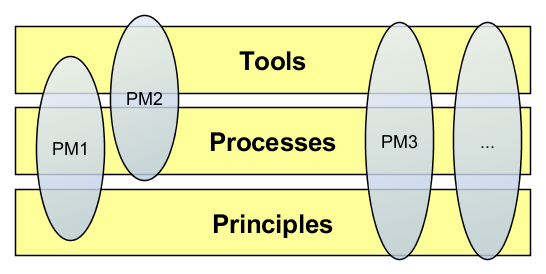8.1 Introduction
The course title is “IT support for project management processes”. As we shown earlier in the Preface: the process should precede the tool. In this section we deal with and discuss this topic in more detail. What is a process? What is IT support? What are the basic factors affecting process and IT support? How they are related?
Role of IT support
Considering the previous lectures we can setup the following relationships between different levels of project management: IT support is based on tools, tools are determined by the applied processes, and processes are built upon the elaborated principles.

Figure 8.1: Principles, processes, tools and IT support
Examples:
- A PRINCE2 principle is “Learn from experience”, a similar Lean Software Development principle is “Amplify learning”
- “Initiating a project” is a PRINCE2 process
- “Risk Register” is a PRINCE2 tool, while Gemba is a Lean tool. Work Breakdown Structure and Gantt Charts are general project management tools, without any kind of concrete software implementation, e.g. a Gantt chart could be implemented in a sheet of paper as well. After all, it is clear that IT support can significantly boost up project management.
- In some cases it is not straightforward to categorize, e.g. the PDCA cycle could be considered as a general tool or as a process as well.
Project management methodologies
The previous lectures introduced some of the well-known and popular project management methodologies. Different methodologies may share principles, processes and tools, e.g. Lean and Agile methodologies have several similar principles. The methodologies never prescribe a concrete software application for project management. Some methodologies concentrate only on one part (e.g. PMI is process oriented while Lean is principle oriented) while others deals with all levels (e.g. Prince2).

Figure 8.2: Methodologies in view of principles, processes and tools
IT support for project management processes
IT support has two parts: hardware support and software support. In this course we deal with the software part only assuming that the needed hardware is available.
Software support is a very important step, it improves and enhances the project’s success rate, but first of all the principles, processes and tools determine the project structure and success. Therefore these have to be elaborated and clearly developed. There are three scenarios:
- If any of principles, processes or tools are problematic, not well understood, misunderstood or badly chosen then the project will be very challenging independently from the project size, stakeholders’ experience or any other factor. In these cases the software application will not and cannot solve the problems and support the project.
- If all of principles, processes and tools are well understood and appropriately chosen then the project will have a very high chance for success (it will mostly depend on the people and skillset). In these cases
- If appropriate software solution is selected then it will increase the probability of project’s success
- If inappropriate software solution is selected then it will decrease the probability of project’s success
Considering the previous scenarios, the first thing must be the elaboration of the appropriate project background (principles, processes, tools) and to clearly understand them. Without these steps software support is meaningless.
Software support: selecting an appropriate software application and customizing it according the defined principles, processes and tools. Customization means elaboration of appropriate views and so on.